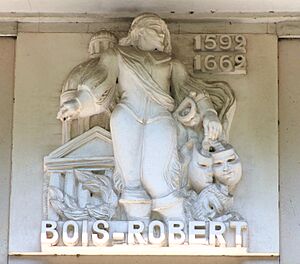François le Métel de Boisrobert facts for kids
Quick facts for kids
François le Métel de Boisrobert
|
|
|---|---|
 |
|
| Born | 1 August 1592 Caen |
| Died | 30 March 1662 (aged 69) Paris |
| Occupation | Writer, poet, playwright and abbot |
| Language | French |
| Nationality | French |
| Period | 17th-century French literature |
| Notable awards | Académie française (1634-1662) |
François le Métel de Boisrobert was a famous French writer, poet, and playwright. He lived from 1592 to 1662. He was also a "courtier," which means he spent a lot of time at the king's court.
Contents
Life of a French Writer
Early Life and Career
François le Métel de Boisrobert was born in a French city called Caen. He first studied to become a lawyer. He worked in that job for a while in a city called Rouen.
In 1622, he moved to Paris. There, he started working at the royal court. He even helped with a ballet performance at the Louvre palace.
Working with Important Leaders
In 1623, Boisrobert met Cardinal Richelieu. Cardinal Richelieu was a very powerful leader in France at that time. Boisrobert became one of five poets who helped Richelieu with his writing.
It was Boisrobert who suggested creating the Académie française. This is a famous French group that works to protect the French language. He was one of its first and most active members. Because of his hard work, he became quite rich.
In 1630, Boisrobert visited Rome. There, he impressed Pope Urban VIII. The Pope made him a "canon," which is a type of priest.
Later Years and Works
After Cardinal Richelieu died, Boisrobert worked for another important leader, Cardinal Mazarin. He stayed loyal to Mazarin during a time of civil unrest called the Fronde.
In his later years, Boisrobert spent more time on his duties as a priest. He wrote many comedies, which are plays meant to be funny. He also helped write other plays, including La Belle Plaideuse. He even contributed to a famous play by Molière called L'Avare.
Major Works
Boisrobert wrote many plays and stories during his career. Here are some of his notable works:
- Pyrandre et Lisimène ou l'Heureuse tromperie (1633)
- Les Rivaux amis (1639)
- Les Deux Alcandres (1640)
- La Belle Palène (1642)
- Le Couronnement de Darie (1642)
- La Vraie Didon ou Didon la chaste (1643)
- La Jalouse d'elle-même (1650)
- Les Trois Orontes (1652)
- L'hiver de Paris
- La Folle gageure ou les divertissements de la comtesse de Pembroc (1653)
- Cassandre, comtesse de Barcelone (first performed at the Hôtel de Bourgogne on October 31, 1653)
- L'Inconnue (1655)
- L'Amant ridicule (1655)
- Les Généreux ennemis (1655)
- La Belle plaideuse (1655)
- La Belle invisible ou les Constances éprouvées (1656)
- Les Apparences trompeuses (1656)
- Les Coups d'Amour et de Fortune (1656)
- Théodore, reine de Hongrie (1658)

